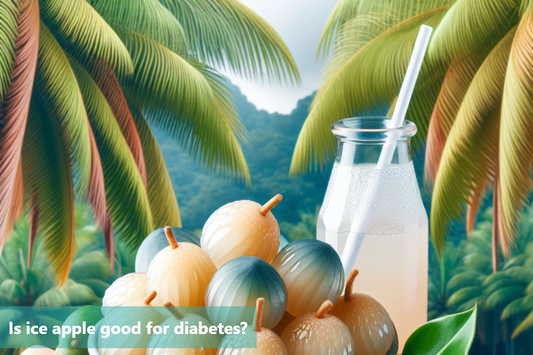In the realm of health management, diabetes stands as a significant challenge for many individuals. It's not merely a condition; it's a lifestyle that demands mindful choices, especially when it comes to diet. The correlation between diabetes and diet is pivotal, and one aspect that requires attention is the glycemic index.
Diabetes, a condition characterized by elevated blood sugar levels, prompts us to be vigilant about what we consume daily. It's not just about cutting down on sugar but understanding how different foods impact our blood sugar. This brings us to the concept of the glycemic index, a numerical scale that rates the speed at which various foods, including fruits, raise blood sugar levels.
Diving into the intricacies of managing diabetes, our dietary choices play a crucial role. The glycemic index becomes a guiding factor, helping us navigate the vast array of food options. Now, let's zoom in on how this index specifically relates to our fruit consumption. It's not about avoiding fruits altogether, but rather making informed decisions to ensure that our fruit choices align with our goal of maintaining stable blood sugar levels. Let's explore this further in the upcoming sections, where we'll unveil the fruits that might need a second thought and discover how to strike a balance between enjoying nature's sweet offerings and managing diabetes effectively.
Understanding the Glycemic Index
The glycemic index (GI) serves as a numerical guide, shedding light on how swiftly various foods can elevate blood sugar levels. For individuals with diabetes, this tool becomes invaluable in making informed decisions about what goes on their plate.
Foods are categorized on the glycemic index scale, with high-GI foods causing a rapid spike in blood sugar, while low-GI foods lead to a more gradual increase. Understanding this dynamic is crucial for managing diabetes effectively. High-GI foods can be a double-edged sword for those with diabetes, as they cause a quick surge in blood sugar, potentially leading to complications.
Conversely, low-GI foods are the heroes for individuals aiming to keep blood sugar levels steady. They offer sustained energy release and are generally more diabetes-friendly. This doesn't mean eliminating high-GI foods entirely, but rather being mindful of their consumption and balancing them with low-GI options.
The glycemic index (GI) is a measure of how quickly a food raises blood sugar levels. Foods with a GI of 70 or above are considered high, 56-69 is moderate, and 55 or below is low.
While some of these fruits have a moderate GI, they can still be consumed in moderation, particularly if paired with low-GI foods or balanced with protein and fats to minimize blood sugar spikes.
In the context of fruits, the glycemic index becomes a compass for navigating the orchard. Some fruits may surprise us with their impact on blood sugar levels. As we explore further, we'll uncover which fruits fall into the high-GI category, warranting caution, and which ones can be embraced more freely in a diabetes-conscious diet. Understanding the glycemic index is not just about numbers; it's about empowering ourselves with knowledge to make choices that positively impact our health.
Fruits with High Glycemic Index
As we venture into the orchard of fruit choices, it's essential to identify those with a higher glycemic index (GI) – the ones that might cause a more abrupt surge in blood sugar levels for individuals managing diabetes.
Bananas, though a beloved fruit, are surprisingly high on the GI scale. Their natural sweetness can lead to a quicker elevation in blood sugar, highlighting the importance of enjoying them in moderation. Similarly, watermelon, while refreshing, has a higher GI due to its natural sugars.
Mangoes, with their tropical allure, are another fruit to approach with caution. Their delicious taste comes with a higher glycemic impact, urging us to savor them in smaller portions.
The key here is not to banish these fruits from our diet but to approach them with mindfulness. Moderation becomes the guiding principle – a small serving of a high-GI fruit can still be a part of a diabetes-friendly diet. Pairing them with low-GI foods or incorporating them into meals with fiber-rich elements can help mitigate their impact on blood sugar levels.
Fruit |
Glycemic Index (GI) |
Reason to Avoid/Moderate |
|---|---|---|
Watermelon |
72 |
High GI, can cause rapid blood sugar spikes |
Pineapple |
66 |
Moderate to high GI, impacts blood sugar |
Banana (ripe) |
51-62 |
Higher GI when fully ripe |
Mango |
51 |
|
Grapes |
49-59 |
Moderate GI, high natural sugars |
Lychee |
50 |
High natural sugar content |
Dates |
42-55 |
High sugar, can quickly raise blood sugar |
Papaya |
60 |
Moderate GI, should be consumed in small amounts |
Raisins |
64 |
Concentrated sugar content |
Understanding the glycemic index of fruits is a tool for strategic decision-making. Armed with this knowledge, we can make conscious choices, ensuring that our fruit consumption aligns with our diabetes management goals. In the next section, we'll pivot towards a more positive note, exploring fruits that can be embraced more freely in a diabetes-conscious diet.
Balancing Fruit Consumption in Diabetes
Now that we've identified fruits with a higher glycemic index, let's shift our focus to crafting a diabetes-friendly diet that embraces the natural sweetness of fruits without compromising blood sugar control.
Choosing fruits with a lower glycemic index is a smart starting point. Berries, such as strawberries, blueberries, and raspberries, are not only delicious but also low on the glycemic index. Their fiber content slows down the absorption of sugars, making them an excellent choice for individuals with diabetes.
Apples and pears, when consumed with their skin, provide a good dose of fiber, contributing to a slower rise in blood sugar. Opting for whole fruits instead of fruit juices is another wise move. Whole fruits contain fiber, which helps regulate blood sugar levels, whereas juices can lead to a quicker spike.
Pairing fruits with other foods can further enhance their diabetes-friendly profile. For example, combining a handful of almonds with an apple can balance the fruit's impact on blood sugar. The healthy fats and protein in nuts contribute to a more gradual rise in blood sugar, offering a satisfying and blood sugar-steadying snack.
Additionally, integrating fruits into meals rich in fiber and lean proteins helps create balanced, diabetes-conscious plates. For instance, adding slices of a low-GI fruit to a bowl of oatmeal with nuts and seeds makes for a nutritious and blood sugar-friendly breakfast.
In essence, the key lies in diversity and balance. Experimenting with various low-GI fruits, combining them thoughtfully with other food groups, and paying attention to portion sizes can transform fruit consumption from a concern to a delightful and healthful part of a diabetes-conscious diet. As we conclude, let's recap the essential points and emphasize the empowerment that comes with informed choices in managing diabetes through our dietary decisions.
Consuming fruits moderately
In closing, navigating the landscape of diabetes and fruit consumption requires a thoughtful approach. We've explored the crucial concept of the glycemic index, understanding how it influences blood sugar levels and impacts our choices in the fruit aisle.
Identifying fruits with a higher glycemic index, such as bananas, watermelon, and mangoes, doesn't imply exclusion but rather calls for moderation. Making informed choices involves balancing these fruits with lower-GI options and incorporating them strategically into meals to mitigate their impact on blood sugar.
Our journey led us to the diabetes-friendly realm of berries, apples, and pears, emphasizing the significance of choosing fruits with a lower glycemic index. These choices, coupled with smart combinations like fruits with nuts or incorporating them into fiber-rich meals, contribute to a balanced and blood sugar-friendly diet.
The takeaway here is empowerment through knowledge. By being aware of the glycemic index and making conscious choices, individuals managing diabetes can savor the sweetness of fruits without compromising their health.
However, it's essential to acknowledge the uniqueness of each individual's health journey. Consultation with healthcare professionals provides personalized guidance tailored to specific needs. Every person's response to foods, including fruits, can differ, making professional advice invaluable in crafting a diet that aligns with individual health goals.
Let's celebrate the versatility and natural goodness of fruits, appreciating them as allies rather than adversaries in the journey of diabetes management. Through mindfulness, informed choices, and collaboration with healthcare experts, we can strike a balance that promotes both enjoyment and well-being on the path to a healthier life with diabetes.
This Blog post is an initiative by DiabeSmart, to provide accurate and Nutritionist / Doctor approved information related to Diabetes. DiabeSmart is India's first Food brand designed specifically for Diabetics, that has been clinically tested on Diabetics and Pre-Diabetics to deliver 55% - 70% lower Sugar spikes. DiabeSmart is part of Lo! Foods - India's leading brand for Everyday Functional Health foods.











